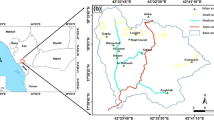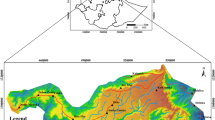Abstract
Landslide susceptibility mapping is a necessary tool in order to manage the landslides hazard and improve the risk mitigation. In this research, we validate and compare the landslide susceptibility maps (LSMs) produced by applying four geographic information system (GIS)-based statistical approaches including frequency ratio (FR), statistical index (SI), weights of evidence (WoE), and logistic regression (LR) for the urban area of Azazga. For this purpose, firstly, a landslide inventory map was prepared from aerial photographs and high-resolution satellite imagery interpretation, and detailed fieldwork. Seventy percent of the mapped landslides were selected for landslide susceptibility modeling, and the remaining (30%) were used for model validation. Secondly, ten landslide factors including the slope, aspect, altitude, land use, lithology, precipitation, distance to drainage, distance to faults, distance to lineaments, and distance to roads have been derived from high-resolution Alsat 2A satellite images, aerial photographs, geological map, DEM, and rainfall database. Thirdly, we established LSMs by evaluating the relationships between the detected landslide locations and the ten landslides factors using FR, SI, LR, and WoE models in GIS. Finally, the obtained LSMs of the four models have been validated using the receiver operating characteristics curves (ROCs). The validation process indicated that the FR method provided more accurate prediction (78.4%) in generating LSMs than the SI (78.1%),WoE (73.5%), and LR (72.1%) models. The results revealed also that all the used statistical models provided good accuracy in landslide susceptibility mapping.












Similar content being viewed by others
References
Agence Nationale des Ressources Hydrauliques (2014) Inventaire des données de précipitation mensuelles et annuelles des 05 stations hydroclimatique de Azazga “Azazga Ecole, Yakourene, Tala Gassi, Aghribs, and Freha” pour la période de 64 ans (1950-2014).
Aleotti P, Chowdhury R (1999) Landslide hazard assessment: summary review and new perspectives. Bull Eng Geol Environ 58:21–44. https://doi.org/10.1007/s100640050066
Ayalew L, Yamagishi H (2005) The application of GIS-based logistic regression for landslide susceptibility mapping in the Kakuda-Yahiko Mountains, Central Japan. Geomorphology 65:15–31. https://doi.org/10.1016/j.geomorph.2004.06.010
Bai S, Wang J, Lu G, Zhou P, Hou S, Xu S (2010) GIS-based logistic regression for landslide susceptibility mapping of the Zhongxian segment in the Three Gorges area, China. Geomorphology 115:23–31. https://doi.org/10.1016/j.geomorph.2009.09.025
Bougdal R, Larriere A, Pincent B, Panet M, Bentabet A (2013) Les glissements de terrains du quartier Bélouizdad, Constantine, Algérie. Bull Eng Geol Environ 72,189–202. https://doi.org/10.1007/s10064-013-0465-8
Barbieri G, Cambuli P (2009) The weight of evidence statistical method in landslide susceptibility mapping of the Rio Pardu Valley (Sardinia, Italy). 18th World IMACS/MODSIM Congress, Cairns, Australia 13–17 July 2009. https://mssanz.org.au/modsim09/G3/barbieri.pdf
Bonham-Carter GF, Agterberg FP, Wright DF (1989) Weights of evidence modelling: a new approach to mapping mineral potential. In: Agterberg FP, Bonham-Carter GF (eds) Statistical Applications in Earth Sciences. Geological Survey of Canada, Ottawa, pp 171–183
Bonham-Carter GF (1994) Geographic information systems for geoscientists: modeling with GIS. Pergamon Press, Ottawa, p 398
Bourenane H, Bouhadad Y, Guettouche MS, Braham M (2014) GIS-based landslide susceptibility zonation using bivariate statistical and expert approaches in the city of Constantine (Northeast Algeria). Bull Eng Geol Environ 74,337–355 (2015). https://doi.org/10.1007/s10064-014-0616-6
Bourenane H, Guettouche MS, Bouhadad Y, Braham M (2016) Landslide hazard mapping in the Constantine city, Northeast Algeria using frequency ratio, weights factor, logistic regression, weights of evidence, and analytical hierarchy process methods. Arabian Journal of Geoscience. https://doi.org/10.1007/s12517-015-2222-8
Bourenane H (2017) Analyse spatiale, évaluation et cartographie des risques naturels : Application à l’aménagement de la ville de Constantine (Nord Est Algérien). Université de l’USTHB, Alger, Thèse de Doctorat Es Sciences, p 300
Bourenane H, Bouhadad Y, Guettouche, MS (2019) Flood hazard mapping in urban area using the hydrogeomorphological approach: case study of the Boumerzoug and Rhumel alluvial plains (Constantine city, NE Algeria). Arab J Geosci 9, 154 (2016). https://doi.org/10.1007/s12517-015-2222-8
Bourenane H, Braham M, Bouhadad Y, Meziani AA (2021a) Spatial distribution, controlling factors and failure mechanisms of the large-scale landslides in the urban area of Azazga city (northern Algeria). Environ Earth Sci 80:313. https://doi.org/10.1007/s12665-021-09607-5
Bourenane H, Bouhadad Y (2021b) Impact of Land use Changes on Landslides Occurrence in Urban Area: The Case of the Constantine City (NE Algeria). Geotech Geol Eng. https://doi.org/10.1007/s10706-021-01768-1
CGS (2010) Seismic microzoning study of the city of Azazga. National Center of Applied Research in Earthquake Engineering CGS (Etape A2: Carte photogéologique). Unpublished Internal report.
CGS (2018) Seismic microzoning study of the city of Azazga. National Center of Applied Research in Earthquake Engineering CGS (Etape A3: Carte géotechnique et données hydrogéologiques). Unpublished Internal report.
Chung CJ, Fabbri AG (2003) Validation of spatial prediction models for landslide hazard mapping. Nat Hazards 30, 451–472 (2003). https://doi.org/10.1023/B:NHAZ.0000007172.62651.2b
Demir G, Aytekin M, Akgun A (2015) Landslide susceptibility mapping by frequency ratio and logistic regression methods: an example from Niksar-Resadiye (Tokat, Turkey). Arab J Geosci. https://doi.org/10.1007/s12517-014-1332-z
Demir G (2018) Landslide susceptibility mapping by using statistical analysis in the North Anatolian Fault Zone (NAFZ) on the northern part of Suşehri Town. Turkey Nat Hazards 92:133–154. https://doi.org/10.1007/s11069-018-3195-1
Gelard JP (1979) Géologie du Nord – Est de la Grande Kabylie (un segment des zones interne de l’orogène littoral maghrébin) – Thèse de doctorat.
Djerbal L, Melbouci B (2012) Le glissement de terrain d’Ain El Hammam (Algérie): causes et évolution. Bull Eng Geol Environ 71:587–597. https://doi.org/10.1007/s10064-012-0423-x
Djerbal L, Alimrina N, Melbouci B, Bahar R (2014) Mapping and Management of Landslide Risk in the City of Azazga (Algeria) Landslide Science for a Safer Geoenvironment pp 463–468. https://doi.org/10.1007/978-3-319-05050-8_72
Djerbal L, Khoudi I, Alimrina N, Melbouci B, Bahar R (2017) Assessment and mapping of earthquake-induced landslides in Tigzirt City. Algeria Natural Hazards 87(3):1859–1879. https://doi.org/10.1007/s11069-017-2831-5
Guirous L, Dubois L, Melbouci B (2014) Contribution à l’étude du mouvement de terrain de la ville de Tigzirt (Algérie). Bull Eng Geol Environ. https://doi.org/10.1007/s10064-014-0624-6
Guzzetti F, Carrara A, Cardinali M, Reichenbach P (1999) Landslide hazard evaluation: a review of current techniques and their application in a multi-scale study, Central Italy. Geomorphology 31:181–216. https://doi.org/10.1016/S0169-555X(99)00078-1
Hadji R, Boumazbeur A, Limani Y, Baghem M, Chouabi A, Demdoum A (2013) Geologic, topographic and climatic controls in landslide hazard assessment using GIS modeling: a case study of Souk Ahras region, NE Algeria. Quatern Int 302:224–237. https://doi.org/10.1016/j.quaint.2012.11.027
Hadji R, Rais K, Gadri L, Chouabi A, Hamed Y (2017) Slope failure characteristics and slope movement susceptibility assessment using GIS in a medium scale: a case study from Ouled Driss and Machroha municipalities, Northeast Algeria. Volume 42, Issue 1, pp 281–300. Arab J Sci Eng 42, 281–300 (2017). https://doi.org/10.1007/s13369-016-2046-1
Hallal N, Dubois L, Bougdal R, Djouder F (2017) Instabilités gravitaires dans la région de Béjaïa (Algérie): Inventaire et appréciation de l’importance relative des différents paramètres conduisant au déclenchement, au maintien ou à l’activation des instabilités. Bull Eng Geol Environ. https://doi.org/10.1007/s10064-017-1050-3
Hallal N, Yelles Chaouche A, Hamai L, Lamali A, Dubois L, Mohammedi Y, Hamidatou M, Djadia L, Abtout A (2019) Spatiotemporal evolution of the El Biar landslide (Algiers): new field observation data constrained by ground-penetrating radar investigations. Bull Eng Geol Environ. https://doi.org/10.1007/s10064-019-01492-4
Jelínek R, Wagner P (2007) Landslide hazard zonation by deterministic analysis (Veľká Čausa landslide area, Slovakia) Landslides (2007) 4:339–350. https://doi.org/10.1007/s10346-007-0089-9
Karim Z, Hadji R, Hamed Y (2019) GIS based approaches for the landslide susceptibility prediction in Setif Region (NE Algeria). Geotech Geol Eng 37(1):359–374. https://doi.org/10.1007/s10706-018-0615-7
Kevin LKW, Tay LT, Lateh H (2011) Landslide hazard mapping of Penang Island using probabilistic methods and logistic regression. Imaging Systems and Techniques (IST), 2011 I.E. International Conference, pp 273–278
Laribi A, Walstra J, Ougrine M, Seridi A, Dechemi N (2014) Use of digital photogrammetry for the study of unstable slopes in urban areas: case study of the El Biar landslide. Algiers Engineering Geology 187(2015):73–83. https://doi.org/10.1016/j.enggeo.2014.12.018
Lee S, Min K (2001) Statistical analysis of landslide susceptibility at Yongin, Korea. Env Geol 40,1095–1113. https://doi.org/10.1007/s002540100310.
Lee S, Pradhan B (2007) Landslide hazard mapping at Selangor, Malaysia using frequency ratio and logistic regression models. Landslides 4:33–41. https://doi.org/10.1007/s10346-006-0047-y
ORGM (1996) Geological map of Azefoune at 1/50 000 scal. Publ. Serv. Géol, Algérie
Merghadia A, Yunusb AP, Douc Jd, Whiteleye J, ThaiPhamg B, Tien Buihn B, Avtari R, Boumezbeur A (2020) Machine learning methods for landslide susceptibility studies: A comparative overview of algorithm performance. Earth-Science Rev. https://doi.org/10.1016/j.earscirev.2020.103225
Ozdemir A, Altural T (2012) A comparative study of frequency ratio, weights of evidence and logistic regression methods for landslide susceptibility mapping: Sultan Mountains, SW Turkey. J Asian Earth Sci. https://doi.org/10.1016/j.jseaes.2012.12.014
Pradhan B, Lee S (2010) Delineation of landslide hazard areas using frequency ratio, logistic regression and artificial neural network model at Penang Island, Malaysia. Environ Earth Sci 60:1037–1054. https://doi.org/10.1007/s12665-009-0245-8
Pradhan B, Youssef A (2010) Manifestation of remote sensing data and GIS on landslide hazard analysis using spatial-based statistical models. Arab J Geosci 3:319–326. https://doi.org/10.1007/s12517-009-0089-2
Shahabi H, Ahmad BB, Khezri S (2012) Evaluation and comparison of bivariate and multivariate statistical methods for landslide susceptibility mapping (case study: Zab basin). Arab J Geosci. https://doi.org/10.1007/s12517-012-0650-2
Thiery Y, Malet JP, Sterlacchini S, Puissant A, Maquaire O (2007) Landslide susceptibility assessment by bivariate methods at large scales: application to a complex mountainous environment. Geomorphology 92:38–59. https://doi.org/10.1016/j.geomorph.2007.02.020
Terlien MT, Van Westen CJ, Van Asch ThW (1995) Deterministic modelling in GIS-based landslide hazard assessment. In: Carrara A, Guzetti F (eds) Geographical information systems in assessing in natural hazards. Kluwer, The Netherlands, pp 57–77
Tien Bui D, Lofman O, Revhaug I, Dick O (2011) Landslide susceptibility analysis in the Hoa Binh province of Vietnam using statistical index and logistic regression. Nat Hazards 59:1413–1444. https://doi.org/10.1007/s11069-011-9844-2
Van Westen CJ (1997) Statistical landslide hazard analysis. ILWIS 2.1 for Windows application guide. ITC publication, Enschede, The Netherlands, pp 73–84
Van Westen CJ, Rengers N, Soeters R (2003) Use of geomorphological information in indirect landslide susceptibility assessment. Nat Hazards 30:399–419. https://doi.org/10.1023/B:NHAZ.0000007097.42735.9e
Varnes DJ (1978) Slope movement, types and processes. In: Schuster RL, Krizek RJ (Eds) Landslides, analyses and control. National Academy of Science, Report 176, Washington, DC, pp 11–35
Varnes DJ (1984) Landslide Hazard Zonation, a review of principles and practice. IAEG Commission on Landslides. UNESCO, Paris, p 63
Yalcin A, Reis S, Aydinoglu AC, Yomralioglu T (2011) A GIS-based comparative study of frequency ratio, analytical hierarchy process, bivariate statistics and logistics regression methods for landslide susceptibility mapping in Trabzon, NE Turkey. CATENA 85:274–287. https://doi.org/10.1016/j.catena.2011.01.014
Yilmaz I (2009) Landslide susceptibility mapping using frequency ratio, logistic regression, artificial neural networks and their comparison: a case study from Kat landslides (Tokat-Turkey). Comput Geosci 35(6):1125–1138
Yesilnacar E, Topal T (2005) Landslide susceptibility mapping: a comparison of logistic regression and neural networks methods in a medium scale study, Hendek region (Turkey). Eng Geol 79(3–4):251–266. https://doi.org/10.1016/j.enggeo.2005.02.002
Zhou G, Esaki T, Mitani Y, Xie M, Mori J (2003) Spatial probabilistic modeling of slope failure using an integrated GIS Monte Carlo simulation approach. Eng Geol 68:373–386. https://doi.org/10.1016/S0013-7952(02)00241-7
Acknowledgements
This research was supported by the National Center of Applied Research in Earthquake Engineering (CGS). The authors would like to express their sincere appreciation and gratitude to the reviewers and the Editor-in-Chief for their valuable comments, suggestions and corrections for improving the original manuscript. The authors would like also to thank the Algerian Space Agency (ASAL) for providing Alsat2A satellite imagery and the National Hydrous Resources (ANRH) for providing rainfall data. Thanks are also due to the DUAC (Direction de l’Urbanisme, de l’Aménagementet de la Construction) of Tizi-Ouzou for providing various datasets needed in this research.
Author information
Authors and Affiliations
Corresponding author
Rights and permissions
About this article
Cite this article
Bourenane, H., Meziani, A.A. & Benamar, D.A. Application of GIS-based statistical modeling for landslide susceptibility mapping in the city of Azazga, Northern Algeria. Bull Eng Geol Environ 80, 7333–7359 (2021). https://doi.org/10.1007/s10064-021-02386-0
Received:
Accepted:
Published:
Issue Date:
DOI: https://doi.org/10.1007/s10064-021-02386-0




